Book Reviews
by Max Ink Staff Writers

"AC/DC FAQ" by Susan masino
AC/DC FAQ
Author: Susan Masino
Review By Sal Serio
Publisher: Backbeat Books
Posted: Apr 2015
(9390) Page Views
There’s probably no one on the planet more qualified to write the ultimate fan’s guide to AC/DC than Madison journalist Susan Masino. Having first met the iconic and diminutive Australian rock group in 1977 during their first tour of the United States, Masino struck up a friendly rapport with the band, which has lasted over the years. Additionally, Masino has developed a professional relationship with AC/DC, having interviewed them a few times, including, perhaps, the only interview with the entire band at once - including Bon Scott - in late 1977. Masino also published the book “Let There Be Rock: The Story Of AC/DC” in 2006.
So, do you think you know everything there is to know about AC/DC? Well, think again! Even at over 330 pages, I found “AC/DC FAQ” to be a quick read, fascinating and engrossing. Literally every page included gems of fun and intriguing information about the band that even a longtime fan like myself was completely unaware of. Masino interjected her own personality and “insiders” perspective to the book to keep the story fresh, interesting, and somewhat personal, which keeps the read from being dry or formulaic. Included are ample photos of rare memorabilia and live shots to enjoy.
Obviously, I highly endorse and recommend this book, but should you need some examples of what to look forward to, then, here you go: Detailed stories of the group’s formative years, and the influence that older brother George Young (along with his partner Harry Vanda and producer Ted Albert) had on Malcolm and Angus’ career. An in depth exposé of singer Bon Scott’s early musical endeavors, before joining AC/DC (no, Bon was not their first singer!). The complete transcription of Susan’s taped interview with all five members of the original classic-era line-up of AC/DC following a gig in Milwaukee in 1977. Technical gear-head breakout of the guitars and amplification units that the Young brothers have used over the years. The real story of the statuesque Rosie from Tasmania, who literally rocked Bon Scott’s world and provided the inspiration to one of AC/DC’s all-time great songs “Whole Lotta Rosie”! A breakdown of each and every AC/DC album (import and domestic) and everything one would need to know regarding those recordings. Stories and insights from the group’s road crew, including their early tour manager and eventual pyrotechnic professional. There’s also a rundown of every tour that AC/DC ever played.
Of course, no book about AC/DC would be complete without a look at the sad and tragic ending to the life of one of rock ‘n roll’s most charismatic and unique front men, Ronald “Bon” Scott. “AC/DC FAQ” takes the reader through the bizarre and unfortunate events of February 18, 1980, which led to Scott’s passing, alone, passed out in an automobile in London after a night of heavy drinking, or “death by misadventure”, as is often stated. However, the book also provides insight to how AC/DC rebounded from this tragedy with the “Back In Black” album, a tribute to Bon Scott, and one of the most massive successes the recording industry has ever seen. Included are also accounts of other tributes to the late singer, such as the life-size bronze cast of Bon that stands near the ocean shore in Fremantle, Australia, nearby to where Scott worked in the crayfish boats before adopting his persona as a brazen and ballsy rock ‘n roll singer. Another curious story came during the recording of “The Razors Edge” album, in 1990, while listening to the album’s playback, a backing vocal track was discovered that no one recalled recording. The singer on that track sounded just like Bon Scott.
Susan Masino will be at the Bowl-A-Vard Lanes in Madison, WI, (2121 East Springs Drive) on Saturday, April 18 from 7:00 to 9:00 pm for the official “AC/DC FAQ” publishing party. There will be books to purchase, and Masino will be signing and greeting fans. At 9:00 the festivities continue with a live performance by the band Denim N Leather. Get it hot! Masino will also be featured on “The Jimmy K Show” on maxinkradio.com, at 7:00 pm, Tuesday, April 14, to discuss “AC/DC FAQ”.
Author Susan Masino Online
• Website • Facebook

Punk Rock Blitzkrieg - My Life As A Ramone
Author: Marky Ramone with Rich Herschlag
Review By Michael Sherer
Publisher: Simon and Schuster
Posted: Mar 2015
(6040) Page Views
Born Marc Bell in ‘56 in Crown Heights, Brooklyn, NY, the drummer that’s best known as Marky Ramone certainly paid his dues before becoming a Ramone in ‘78. His very honest and thorough new autobiography tells his story all the way through. We learn that as a member of one of America’s earliest bands to define the heavy metal genre, Dust, Marc tasted a bit of real success with them, as they had a record deal with the Karma Sutra/Buddha label and some good opening tour slots. Marc also played with Wayne County, who would go on to be Jayne County, America’s first transsexual act. There was also time and a record with Richard Hell and the Voidoids. Hell was the first to wear torn clothing with safety pins, and influenced the whole punk scene in England, especially the Sex Pistols.
Marc found his biggest success with The Ramones, though. At the ripe age of 22, he replaced the departed Tommy Ramone. Marc was rechristened Marky, and was expected to learn about 40 three minute songs in a very short time for a big tour. Marky would soon discover how dysfunctional the band was. Lead singer Joey’s girlfriend left him for guitarist Johnny, and they barely ever spoke thereafter because of it. Marky would also quickly realize that Joey had an extreme obsessive compulsive disorder and was often dirty with body odor. And he drank to a degree. Dee Dee, the band’s bassist, was a heroin user, serious drinker and was bi polar. None of the band members had much in common other than the music and band. They were constantly being driven on tours, etc., by their driver/tour manager/everything man Monte Melnick. Like John, Joey and Dee Dee, he hailed from Forest Hills, Queens.
Shortly after the joining the band, they began filming the film Rock ‘n Roll High School in Los Angeles. Produced by Roger Corman and directed by Allan Arkush and Joe Dante, it was quite an experience that Marky details vividly. To go from being a struggling musician in Brooklyn to being in a Hollywood movie was quite a culture shock, and it’s in keeping with all the high flying trials and tribulations that Marky, a very down-to-earth, no nonsense kind of guy, lays out in this book.
Marky was often at odds with Johnny, as the guitarist was a very frugal task master, and was quite bossy. For example, he ordered everyone’s seating placement in their van, with John always placing himself in the front and Joey all the way in the back. The constant dysfunctional nature of the band’s dynamics, along with a grueling tour and recording schedule took its toll on Marky, and his already casual drinking steadily escalated. It led to him being dismissed from the band in early ‘83. It also put his marriage to his wife Marion, whom he had known since high school, in jeopardy. She actually kicked him out a couple of times. A hard road to sobriety followed, and all this is openly discussed in the book.
A great story is a life changing experience that occurred in ‘80. Seymour Stein, the head of their record company, Sire, hired legendary but very volatile and erratic Phil Spector, (for a huge sum) to produce the band’s record End Of The Century. The craziness of Spector’s behavior and the lifestyle he led in his Beverly Hills mansion makes for a heck of a story. For example, Spector made John strum an opening chord for one of the songs over fifty times to get it just right, driving John nuts. I was laughing aloud while reading what went on.
After straightening himself out, Marky was asked to rejoin the band in ‘87. This was after his replacement Richie quit abruptly after feeling too much like a hired hand, mainly with John. The final straw was John refusing to give him an equal share of merchandise sales. It was right before a major tour and the band was desperate to fix the problem. Marky was their strongest drummer and fit in the best (when sober), and they missed and needed that. He stayed until the very end, which was ‘96. Marky had played over 1,700 shows with the band by then. So many tales throughout Marky’s life are here up through that last show, in Los Angeles, (it should have been their hometown of NYC) and they continue to the present. It’s a hard book to put down. Highly recommended reading.
Author Marky Ramone with Rich Herschlag Online
• Website

The Haight: Love, Rock, And Revolution - The Photography of Jim Marshall
Author: Jim Marshall with Joel Selvin
Review By Michael Sherer
Publisher: Insight Editions
Posted: Jan 2015
(6338) Page Views
One of the most important factors of Jim Marshall’s great success in capturing the life and times of the Haight-Asbury district of San Francisco during its hippie/psychedelic ascent in the pivotal years of ‘65 to ‘68 is that Marshall had lived in the general area since he was two years old, having moved there from his birthplace of Chicago in ‘36. Marshall had only lived elsewhere for two years, that being NYC from ‘62 to ‘64, where he was very busy on assignments from Columbia, Atlantic and ABC/Paramount Records, essentially launching his photographic pursuit which quickly became a lifelong career. Marshall had taken his first photos in ‘59.
Marshall being truly tuned into into the scene in San Francisco, coupled with him being friends with most of the musicians and movers and shakers, allowed him the the critically key unfettered access and trust with his subjects that his kind of photography is hinged on. Once granted that most coveted access, Marshall inhabited the role of a reporter, the proverbial fly on the wall, never staging a single thing and almost never using a flash on his assortment of at least five Leica rangefinder type cameras. (They all had differing lens millimeter lengths.) The more invisible and discreet he could be, the better. Marshall did this so effectively that his subjects often forgot that he was even there, let alone photographing them. And photograph he did, to the tune of an astonishing million plus frames at the time of Marshall’s passing in ‘10, aged 74.
The Haight - Love, Rock, And Revolution, a 303 paged hard cover photographic book, large sized at 13’ X 9.5”, is a striking collection of images of many major rock figures in their youthful prime, as well day-in-the life photographs of what was happening in general in the area known simply “The Haight.” Released by Insight Editions of San Rafael, California, the book contains a very insightful and long bygone view into a neighborhood that went from being simple and rather ordinary to being the literal nexus, along with New York City’s Greenwich Village, of the counter cultural, youth movement during the heyday of all that the ‘60’s came to symbolize. Containing portraits, the most compelling being of Janis Joplin, as well as candid glimpses of people from different walks of life, street scenes of many sorts, the sundry drug den culture, the frequent concerts and jams as well as the hugely instrumental Human Be-In. This historic event was held in Golden Gate Park on January 14, ‘67, proving to be a prelude to San Francisco’s Summer of Love, which rendered the Haight-Ashbury district the most emblematic symbol of American counterculture and introduced the word “psychedelic” to the world over.
Marshall was right there to capture the radically evolving scene that was entirely rooted and instigated by the generation known as the baby boomers. With Marshall being about a decade older than them, he had the experience and skill set to photograph it all with high expertise while still being friends with virtually everyone that mattered. With both natives and visitors to San Francisco as subjects, the mostly black and white images contain Jimi Hendrix, Jim Morrison, The Grateful Dead, John Lennon, Brian Jones, Janis Joplin, The Beatles, Jefferson Airplane, Allen Ginsburg, Bob Dylan, Timothy Leary, Bill Graham, Chet Helms and more. Illuminating text and context is provided by Joel Selvin, an accomplished and veteran San Francisco based music journalist and author, as well as a close friend of Marshall. Selvin has collaborated with Marshall on virtually every one of the photographer’s books since ‘92.
Amelia Davis is Marshall’s long time and loyal assistant. When Marshall passed in ‘10, hundreds of thousands of images were left in her care. Marshall never married and had no children. It was his photos that Marshall regarded as his children. Davis had the enormous task of going through Marshall’s massive assortment of negatives, and discovered a great amount that Marshall himself had left unaddressed. The neighborhood of the Haight was featured more prominently in this unearthed collection than anything else Marshall had done, before or since. Davis also found a notebook of Marshall’s titled “The Haight,” which contained notes concerning his attempt to have a book publisher pick up a book that Marshall wanted to release in ‘76 about the Haight, but there were no takers. In all, there were approximately 100,000 frames within the negatives of The Haight. Davis teamed up with Selvin to undertake the major undertaking of editing that down to the 305 photos that wound up in this book.
A thoughtful Forward and Afterward are provided by Jorma Kaukonen and John Poppy, respectively. Kaukonen was an original member and guitarist of the Jefferson Airplane and later formed Hot Tuna with fellow Airplane bassist and childhood friend Jack Casidy, and Poppy was a senior editor at the long defunct Look magazine, which was a direct competitor to Life magazine.
Life is an operative word here, as it truly went through historic change during these key years, and with the Haight being an absolute epicenter, this book goes to the heart of the matter. While many other photographers captured the spirit and times of it all, very few possessed the passion, drive, access and wherewithal to produce the goods that Marshall has. In the parlance of the era, it’s quite a trip, man. Highly recommended.
Author Jim Marshall with Joel Selvin Online
• Website
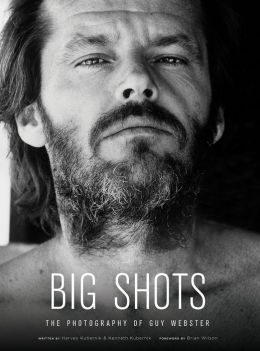
Jack Nicholson
Big Shots - Rock Legends and Hollywood Icons
Author: Guy Webster
Review By Michael Sherer
Publisher: Insight Editions
Posted: Jan 2015
(10744) Page Views
Born in ‘39, Guy Webster grew up in Beverly Hills during the 1950’s and early ‘60’s as the son of Oscar-winning lyricist Paul Francis Webster. This afforded Webster an inside view and easy access to the evolving entertainment world at a level that very few of his peers enjoyed. Webster was in L.A. to see it go through much change and expansion during the ‘60’s and ‘70’s, and was of the same generation of myriad talented and charismatic people beginning their careers at about the same time that Webster was his.
“Big Shots - Rock Legends and Hollywood Icons” is a first rate book of Webster’s photographs, released by Insight Editions of San Rafael, California. Large sized at 12.5’’ X 9.5’’ and with 270 pages richly chronicling the musicians, singers, actors and writers either in their prime, or shortly before becoming well known, Webster captured them all in his native Los Angeles. The thoughtful text was written by L.A. natives and brothers Harvey and Kenneth Kubernik. The forward was penned by Brian Wilson, an early subject and friend of Webster’s from his time photographing Wilson and The Beach Boys.
The text that Webster himself provides is a compelling story, and provides key context. He explains that photography evolved quite incidentally. The turning point was when he was called into the militarily in ‘61, stationed for basic training in Fort Ord, in Monterey, California. Having declared himself a conscientious objector and asking for an office job, the army wound up assigning him to decorate hundreds of Christmas trees, given that Webster was a decorator, artist, painter and sculptor. They then asked Webster if he knew anything about photography. Webster knew nothing, but lied and said he did. The army in turn asked him to teach photography to recruits, as well as how to develop film in a darkroom. Webster took out three photography books from the library, and learned what he needed to know.
When Webster was out of the army three months later, he wanted to continue pursuing photography. Initially aspiring to be a fine-art photographer in the mode of Irving Penn, whom he had just seen an exhibit of, he obtained some Pentax cameras from the “connected” father of a girlfriend, and was on his way. (The father was a mobster.) However, a call from friend and record producer Terry Melcher (son of Dorris Day) changed that course. Needing an album cover for his act the Rip Chords, Melcher asked Webster to take the photos for it. Webster loved music, and the combination of that and his new love of photography delighted him. From there, a flurry of musicians, actors and writers followed, including the Rolling Stones, Mamas and the Papas, The Beach Boys, The Byrds, The Doors, Simon & Garfunkel, Chicago, Charlton Heston, Rita Hayworth, Dean Martin, Natalie Wood, Igor Stravinski, Truman Capote, Zubin Mehta, Barbara Streisand, Jack Nicholson, Candice Bergen, Michelle Pfeiffer and Ted Danson, most of which are included in this book.
It’s a fine collection and excellent retrospective. With both color and black and white images taken at a wide range of sites and in Webster’s studio, this book captures the vibe and ethos of its time, yet doesn’t seem at all dated. Webster has his own voice and was able to photograph his subjects with an ease and naturalness that any photographer should strive for. See it for yourself.
Author Guy Webster Online
• Website

Joe Perry, with David Ritz - ROCKS - My Life In and Out of Aerosmith
Author: Joe Perry with David Ritz
Review By Michael Sherer
Publisher: Simon & Schuster
Posted: Oct 2014
(5472) Page Views
With Aerosmith being such a successful, long lasting, and interesting band of modern times, I was quite curious as to what guitarist and songwriter Joe Perry’s life story would be like. Perry, 64, is refreshingly honest, introspective and thorough in this 371 page book. Many interesting and life spanning photos are included.
Perry takes us back to his childhood in Hopedale, Massachusetts, a small town in the Eastern region of the state. There’s ample information about his family, which played a big role in his life. Perry father’s side was Portuguese and his mother’s was Italian. Neither was at all musical, with Joe’s father being an accountant and his mother being a high school gym teacher. They were supportive, both morally and financially, during Perry’s formative years as he ambitiously pursued his musical goals. This essentially began through Perry having neighbors with teenage boys that played guitar. Hearing and seeing them lured him in to a lifelong love affair with guitars and rock and roll. The same occurred for Perry with the Beatles when they appeared on the Ed Sullivan show in ‘64, which served as a major catalyst for his longing to be in a band. Blues based rock was what became Perry’s muse, with Peter Green of Fleetwood Mac being a prime influence.
Perry goes into detail of how he had an attention deficit disorder growing up, which seriously inhibited his ability to succeed in school. Another major issue was that Perry refused to cut what was considered his long hair to conform to the school’s code, which led to much strife. Perry found solace and great intrigue in the waters and mountains of Lake Sunapee, New Hampshire, where the Perry family retreated to. 133 miles from Hopedale, it was, and still is, Perry’s favorite place. He fell so in love with the waters there that he wanted to become a marine biologist for several years.
Rather than going to college, Perry worked in a factory, which he hated. It was at this time that he had a group called The Jam Band, which featured bassist Tom Hamilton. Perry was very hungry and determined to make it, and asked Hamilton to move with him to Boston, forty miles away, to try their hand at starting a new band in the city. It was at this time that the most pivotal occurrence happened for Perry, which was meeting singer and drummer Steven Tyler in Sunapee, New Hampshire, where the Jam Band frequently played. Tyler, 66, real name Tallarico, who hailed from Yonkers, New York, didn’t initially get along all that well with Perry. However, they became increasingly drawn to each other and realized that something positive was underfoot between them. With Tyler being very extroverted and Perry quite introverted, they were opposites in this way and others. But musically, they seriously clicked, and Perry invited Tyler to join him and Hamilton in Boston for their new band, yet to be assembled. Tyler did so after a short while, with drummer Joey Kramer and co guitarist Ray Tabano, a childhood friend of Tyler’s that Tyler insisted on bringing into the band, completing the lineup. After several months, Tabano proved to be less reliable and dedicated to the band than needed, and was replaced by Brad Whitford.
The book goes on to tell the gradual rise of the band, much due to the guidance and help of the late Frank Connelly, a major concert promoter in Boston and a father figure to everyone in the group, especially Perry. As the band’s star rose, so did drug and alcohol consumption by the band, and particularly of Perry and Tyler, its main songwriters. Their relationship could be very volatile, and Perry’s wife Elyssa Jerret, who was a friend of Tyler’s since they were young, exacerbated things, as she was viewed as a troublemaker by the rest of the band. In ‘79, after a major argument backstage in Cleveland between Tyler and Perry following Elyssa throwing a glass of milk at Terry Hamilton, Tom’s wife, Perry left the band. The book details the struggles of Perry starting over with his own band, The Joe Perry Project. While he was full of energy and free of the turmoil of Aerosmith, he was going back to being a club band and financially struggling, as was Aerosmith with Joe’s replacement, Jimmy Crespo, and a strung out Tyler.
A hugely positive turning point came in ‘83, when Perry met his future wife Billie Montgomery on the set of his music video ‘Black Velvet Pants.’ They began a romance soon after, and married in ‘85. They’re still a very happy couple with two children together, named Roman and Tony. (Perry and Jerret also have a son, named Adrian.) Perry explains how much of a grounding force Billie is, and how key she’s been to his true recovery from drug and alcohol dependency. In ‘84, Perry reconciled with Tyler and rejoined the band.
Another subject addressed in some length is the manager that Perry had as a solo artist and then brought with him to Aerosmith, Tim Collins. Collins was a major factor in resurrecting their career and in insisting the whole band get sober, which may have saved their lives. On a very negative side though, he also played head games with them and was a control freak. Ultimately the bad outweighed the good, and In ‘96 the band voted to let him go.
The ups, downs, and drama never cease with the band, according to Perry, and his tales of it all certainly make for compelling reading. The band has remained popular through the present, and continue to tour with vigor. It’s been 44 years since they began, and Perry looks objectively back with a hard, cold eye, which is how it should be. I highly recommend this book.
Author Joe Perry with David Ritz Online
• Website
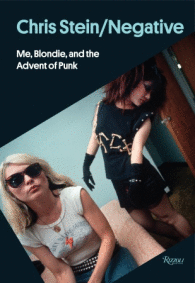
Chris Stein/Negative - Me, Blondie, and the Advent of Punk
Author: Chris Stein
Review By Michael Sherer
Publisher: Rizzoli
Posted: Oct 2014
(4217) Page Views
While Chris Stein is best known as a co-guitarist and songwriter in Blondie, the band he co-founded with Deborah Harry in ‘74, he was taking a copious amount of still photos before he started playing guitar seriously, and never stopped. Some background history is in order here to provide the context for Stein’s new photography based book.
Stein, 64, who grew up in Brooklyn, NYC, began photographing at the age of eight. Stein attended the School Of Visual Arts (SVA) in Manhattan in ‘66 and ‘67 as he was finding himself. He then left “to be a hippie,” as he says. The environs and ethos of the the Village, Washington Square Park, The Bowery, and downtown Manhattan in general shaped Stein’s own identity. Returning to SVA at the dawn of the ‘70’s as he was newly into his 20’s, Stein decidedly was a photography major. Seeing flyers for a relatively new band called New York Dolls in the lobby bulletin boards of SVA, Stein was curious about their over the top drag/androgynous looks. He went to see them at the long-defunct Mercer Arts Center in downtown Manhattan. Opening for them was a another new band called Magic Tramps. Stein quickly fell in with them, especially their late lead singer Eric Emerson. It was Emerson that led Stein to the first performance of a girl group that the mother of Eric’s child, Elda Gentile, had founded. They were called the Stillettoes, and featured Deborah Harry, then unknown. Chris was smitten with her, and in short time was able to join the group as guitarist, mainly to be near Harry. Friendship turned to romance between them, and they would go on to form Blondie together shortly after. 40 years on, and long after their romance ended in the late ‘80’s, they’re still best friends and business partners in the revived Blondie of ‘97, after having broken up in ‘82.
Naturally, Stein’s relationship with Harry fostered a comfortable and less guarded rapport for Stein to photograph her, which he did from their start as unknowns. As Blondie’s star was rising to great heights a few years later, many other photographers and publications were clamoring to photograph Harry. She says in the book that she finds Stein’s images to be the most revealing of all, and has said that they’re her favorite.
This fine, 200-plus paged, 9” X 12” publication from high end Rizzoli features lots of these images, some of which have never been published. While Harry is the most present, there are many other subjects, including, in random order, Eric Emerson, downtown Manhattan, London, England, the Heartbreakers, Richard Hell, the Ramones, Brooklyn’s Coney Island, Jayne County, Divine, the Stillettoes, Blondie band members, Legs McNeil, Iggy Pop, Cherie Currie, Joan Jett, Kim Fowley, Devo, B52s, Rodney Bingenheimer, David Bowie, Chrissie Hynde, Sting, Talking Heads, Chic, John Waters, Stiv Bators, William Burroughs, and Any Warhol.
Stein certainly has his own voice and the mandatory “good eye” that a serious photographer must have. Harry noted recently that she would attempt to recreate with Stein’s camera what he had just done with it, but was never able to capture the same elusive sensibility in her frames. Some of Stein’s images are of well known people in their formative years, before they became at all famous. Their candor and relative innocence is ever present in the work. With Blondie touring throughout the world in their peak period of the latter ‘70’s, Stein was able take photos in places as far flung as Bangkok, Thailand. Few things inspire and invigorate a photographer as brand new, exotic, quixotic, or at least unique territories so far from home.
With forwards by Stein, Harry, and Glenn O’Brien, and an afterward by Shepard Fairey, there is much in the way of thoughtful, insightful, and descriptive text to accompany Stein’s predominately black and white photographs, mostly taken with the classic and sturdy Nikon F series 35 millimeter camera.
Although Stein’s once-beloved downtown Manhattan is hardly recognizable from what it was during its dangerous and crumbling state of the ‘70’s, salient story telling and the freezing of time via the powerful medium of photography will never change. This is positively the case in Stein’s new book, Negative. Go snap it up.
Author Chris Stein Online

Rock And Roll Stories - Lynn Goldsmith
Author: Lynn Goldsmith
Review By Michael Sherer
Publisher: Abrams books
Posted: Dec 2013
(5437) Page Views
Lynn Goldsmith’s first and clear choice for subject matter to photograph is musicians. She’s been capturing them in a compelling and candid fashion for fifty years. (Goldsmith has a photo of hers published of the legs and feet of the Beatles in their Cuban-heeled boots in ‘64, at the height of Bealtlemania.)
Goldsmith’s newly issued 399 page, large-sized hardcover book is the most complete retrospective of her work yet. The cover dons a striking image of her then live-in boyfriend Bruce Springsteen. It was snapped in ‘78, by which time Springteen had become a major star since breaking through three years prior with his Born To Run record. The leather jacket he’s wearing is Goldsmith’s, and after she had sold off some of her clothing in ’96, which included the jacket, it wound up in the Rock And Roll Hall of Fame Museum in Cleveland. This was unbeknownst to Goldsmith until later. (Springsteen, by the way, felt it had too many studs and was too ostentatious for his taste.)
Born in Detroit in ’48, Goldsmith started photographing as a child after her father, who was photographing and had a darkroom himself, gave her a Baby Brownie camera and later a superior Isola one. Goldsmith used them earnestly to photograph her first subjects: Dolls and her family. Some of these images appear in the first pages of her new book.
Goldsmith relocated to NYC in ’69, where her older sister Ellen was living. Although Goldsmith was seriously into photography, the passion for the medium and art would escalate further in the imminent years to follow. First to come were short stints at Elektra Records in their promotional department and then as co-manager of Grand Funk Railroad, with the late Andy Cavaliere. When Goldsmith walked away from that role in the early ‘70s, she carried with her some disillusionment with being involved with the business side of things. This helped Goldsmith to crystallize the realization that it was photography that served as her guiding light and muse, and she pursued it full tilt from then on. Goldsmith loved and fed off the vibes and interactions it brought, and made her photo studio, as she worded it, “A crucible of positive energy.”
While musicians have been the subjects that resonate most with her, she’s also photographed many actors, politicians, athletes, scientists, and businessmen. However, Goldsmith truly loves music above all, and is a singer herself. This handsome book is chock-full of very recognizable musicians that reflect both Goldsmith’s and the subjects’ personalities and love for what they do. There are far too many artists to list, so get the book for yourself and find out. You’ll certainly do what fellow Michiganian Bob Seeger brilliantly sang about: Turn The Page.
Author Lynn Goldsmith Online
• Website
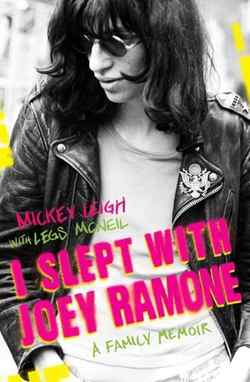
I Slept With Joey Ramone
I Slept with Joey Ramone: A Family Memoir
Author: Mickey Leigh with Legs McNeil
Review By Jeff Muendel
Publisher: Simon and Schuster
Posted: Mar 2010
(23997) Page Views
Although the title of this book suggests a sexual connotation, it is offered in humor. It is written by Joey Ramone’s brother, Mickey Leigh Hyman, and the title refers to the protection his brother offered him growing up. Born Jeffrey Hyman in Queens, New York, Joey Ramone was the tall, quirky lead singer of The Ramones. Often, when young Mickey was scared, his older brother (the future Joey Ramone) would let him sleep in his bed with him. When the Ramones released their debut album in 1976, it ushered in punk rock as a complete artistic entity. The Ramones, fast, ugly, and draped in leather, spoke to the angry youth of the seventies and inspired future bands for decades to come.
This is actually a very sensitive loving book, but includes a frank look at the ugly side of rock ‘n’ roll. With humor and grace, the author shares a troubled story of growing up with an emotionally disturbed brother who becomes a rock star. Joey used rock music to cope with mental illness and in the process launched a punk movement alongside bands like The Talking Heads and Blondie. It was these bands that brought punk to England, influencing the Sex Pistols and changing music history. But regardless of the larger picture, this book’s primary focus is the portrayal of two men who are not unlike Vincent and Theo Van Gogh: an artist who struggled to find his voice while keeping his sanity, and a brother who loved and cared for that artist.
Author Mickey Leigh with Legs McNeil Online
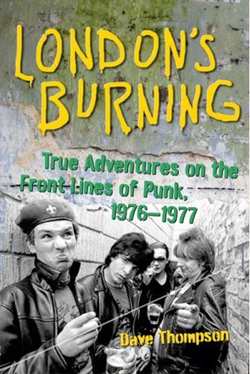
London's Burning: True Adventures on the Front Lines of Punk 1976-1977 by Dave Thompson
London’s Burning: True Adventures on the Front Lines of Punk 1976-1977
Author: Dave Thompson
Review By Jeff Muendel
Publisher: Chicago Review Press
Posted: Jan 2010
(19202) Page Views
Dave Thompson is a fun and energetic writer, and this is the tale of his experience in the London punk scene of ‘76 and ‘77. It is essentially the story of British punk rock as it happened, stripped of hindsight and future legend, and laid bare. Bands bubbling into existence include The Damned during their early gigs and The Sex Pistols swearing through their prime-time television debut. Lesser known groups like The Adverts and Tom Robinson Band are covered, the latter of which are represented by a story wherein the group leads a club full of skinheads through a sing-along anthem called “Glad to Be Gay.” Yes, there are some seriously wild and funny antics. At the same time, though, the book serves up a personal coming-of-age story of a bewildered sixteen-year-old (that would be Thompson) looking not just for fun and music, but for a cultural revolution. The amazing thing is that the author finds a legitimate one right in his back yard, and thanks to Thompson’s natural wit and sharp writing style, we are now all privy to it.
Author Dave Thompson Online
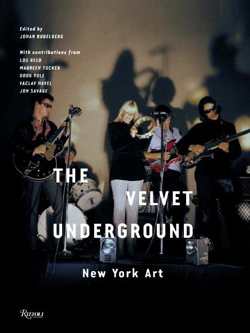
The Velvet Underground: New York Art
The Velvet Underground: New York Art
Author: Johan Kugelberg
Review By Jeff Muendel
Publisher: Rizzoli Press
Posted: Dec 2009
(8713) Page Views
Documenting the formative years of the band, Kugelberg includes newly published photographs starting with the group’s first live show in New York. Andy Warhol is referenced, especially with regard to his Velvet Underground cover and poster designs. Lou Reed’s handwritten music and lyrics are included, and underground press clippings, flyers, handbills, and posters, are added as well to complete a uniquely comprehensive survey of the first rock group ever to transcend genre and embrace subterranean American culture. Also included is a conversation recorded especially for the book between founding members Lou Reed and Maureen Tucker. Kugelberg does a great job archiving a definitive picture of the band’s genesis and development in the extraordinary New York art scene of the mid-sixties.
Author Johan Kugelberg Online
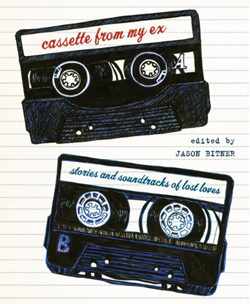
Cassette From My Ex: Stories and Soundtracks of Lost Loves
Cassette From My Ex: Stories and Soundtracks of Lost Loves
Author: Jason Bitner
Review By Jeff Muendel
Publisher: St. Martin's Griffin
Posted: Dec 2009
(6031) Page Views
Mix tapes have been described as “an art form that combines the skills of a DJ with the intimacy of a letter.” Today, the cassette tape has been rendered obsolete, and the art of crafting these sonic calling cards has been relegated to back of the closet, thirty-something nostalgia. Now, thanks to Jason Bitner, the middle-aged can relive lost youth and lost loves. In this book, sixty writers and musicians wax poetic about their own experiences with these charming artifacts and the relationships that inspired them. The stories range from the irreverently sweet, such as the doomed love affair between a Deadhead and a Goth, to the touching, such as the heartbreaking discovery of a former love passing away. Everyone (well, everyone over thirty) will find a story or a song to which they can relate. Just hit play.
Author Jason Bitner Online
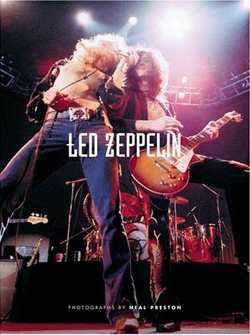
Led Zeppelin: The Neal Preston Collection
Led Zeppelin: The Neal Preston Collection
Author: Neal Preston
Review By Jeff Muendel
Publisher: Omnibus Press
Posted: Dec 2009
(9542) Page Views
Another coffee table book, this photo collection focuses on one of the greatest (and also thoroughly overplayed) bands ever, the mighty Led Zeppelin, While many of the photographs have been widely published, the collection is nonetheless a great record of Zep at their peak. Neal Preston captured many fantastic images of the band showing Jimmy Page, Robert Plant, John Paul Jones and John Bonham in full flight, both on stage and off. The result is this oversized book of color and black-and-white images that stands as an impressive visual reference.
Author Neal Preston Online
View More
Viewing Page 2 - of 4